ikfoundation.org
The IK Foundation
Promoting Natural & Cultural History
Since 1988




stand in a long line, parallel to one another,
between which are snow-filled valleys.

- LONGYEARBYEN:
Assembly/preparation for the fieldwork, meetings with regional institutions and embarking on the expedition ship M/S Malmö. Field documentation (pictures, artwork and text). - KAPP LINNÉ:
Field documentation (pictures, artwork and text). Bone collecting. Testing of field equipment and personal resources. - FORLANDSØYANE:
Rock collecting for comparison with Anton Rolandsson Martin’s rock specimen, a quartzite. Try to establish evidence, if this was the very spot for Martin’s visit in 1758. Surveying to find the ultimate place for the long-term iEYE (Martin’s Eye) project. Bone collecting. Field documentation (pictures, artwork and text). - POOLEPYNTEN:
Surveying to find the ultimate place for the long-term iEYE (Martin’s Eye) project. Bone collecting. Field documentation (pictures, artwork and text). - MAGDALENEFJORDEN:
Tracking historical data from Martens to Martin to the present. Glacier rephotography. Bone collecting. Field documentation (pictures, artwork and text). - BJØRNFJORDEN:
Tracking historical data from Martens to the present. Glacier rephotography. Field documentation (pictures, artwork and text). - SCHEIBUKTA:
Tracking historical data from Martens to the present. Glacier rephotography. Bone collecting. Field documentation (pictures, artwork and text). - SMEERENBURGFJORDEN:
Tracking historical data from the Andrée expedition and from Martens to Martin to the present. Glacier rephotography. Bone collecting. Field documentation (pictures, artwork and text). - KAPP PIKE:
Tracking historical data from the Andrée expedition. Glacier rephotography. Bone collecting. Field documentation (pictures, artwork and text). - HAKLUYTODDEN:
Tracking historical data from Martens to Martin to the present. Ship based. Field documentation (pictures, artwork and text). - LIKHOLMEN:
Tracking historical data from Martens to the present. Field documentation (pictures, artwork and text). - KOBBEFJORDEN:
Tracking historical data from Martens to Martin to the present. Bone collecting. Field documentation (pictures, artwork and text). - ALBERTØYA:
Tracking historical data from Enwall 1873 and to the Andrée expedition 1896 to the present. Glacier rephotography. Field documentation (pictures, artwork and text). - KROSSFJORDEN:
Tracking historical data from Martens to Martin to the present. Glacier rephotography. Bone collecting. Field documentation (pictures, artwork and text). - BLOMSTRANDHALVØYA:
Visit Camp Mansfield. Bone collecting. Field documentation (pictures, artwork and text). - KAPP THORDSEN:
Visiting Svenskhuset. Tracking historical data from Nordenskiöld 1872 - 1873 to the First International Polar Year 1882-1883. Bone collecting. Field documentation (pictures, artwork and text). - BILLEFJORDEN:
Tracking historical data from Nordenskiöld 1872 – 1873. Visit Skansbukta optional Pyramiden. Bone collecting. Field documentation (pictures, artwork and text). - LONGYEARBYEN:
Return to base.
THE FIRST STEPPING STONE… VOYAGE I
As a third “Bridge Builder Expedition” project, initial interdisciplinary work was carried out in the beginning of September in 2016. On the expedition ship M/S Malmö we followed the route the Carl Linnaeus’ apostle Anton Rolandsson Martin made onboard a whaling ship 258 years earlier. Natural and cultural history documentations took part along the entire voyage described by Rolandsson Martin to the 80° north latitude. The research group’s interdisciplinary aims made the working days very efficient and the shared knowledge between various disciplines increased the understanding of the complexity of visited places, as well as its beauty! Bridge Builder Expeditions’ scientific mantra is to explore longterm in-depth knowledge in this way, to understand entirety and details alike.
This was the first of a total of five planned ”Bridge Builder Expeditions Spitsbergen”. The voyage has been regarded successful as we fulfilled the whole route according to plans, even if poor weather conditions at the important sample taking at Forlandsøyanne resulted in that this part of the work had to be carried out during a relatively brief visit at the largest island Midtøya. However, a visit which confirmed that his particular place, Forlandsøyanne, was where Rolandsson Martin spent a few hours in 1758.
This geographical area – with Forlandsøyanne as a centre – has through several centuries by various visitors been described as difficult to access, but of great interest as it from the perspective of Spitsbergen holds an unusually rich biodiversity. We are also planning to lay the foundation to focus on the area for a more extensive contribution within research and documentation in the coming years, by establishing the eco-designed autonomous FIELD STATION | NATURAE OBSERVATIO and linked research projects. Scientific building of networks and further studies of the area will be initiated and are planned to be carried out during the coming years.
Lars Hansen
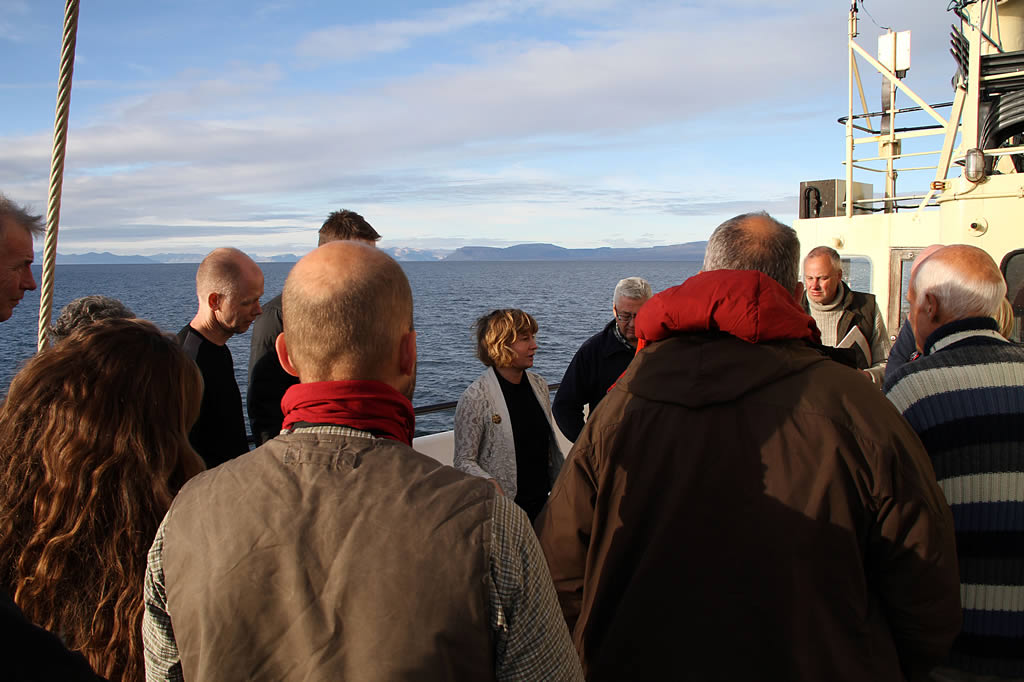 Briefing, Svalbard, September 2016. PHOTO: Love Dalén | Bridge Builder Expeditions Spitsbergen, Voyage I, 2016.
Briefing, Svalbard, September 2016. PHOTO: Love Dalén | Bridge Builder Expeditions Spitsbergen, Voyage I, 2016.
A ROCK SAMPLE AND ANTON ROLANDSSON MARTIN IN 1758
The base for the Bridge Builder Expedition to Spitsbergen is our wish to follow in the footsteps of the Linnaean apostle Anton Rolandsson Martin (1729-1785) who visited this archipelago in 1758. He only got the chance to land once and this for a few hours. But where exactly did he set foot on Spitsbergen? The likely candidate, the Forlandsøyane group of islets sits on the exposed western side of the large island of Prins Karls Foreland. To prove that this was the right place we needed to visit these small islands to collect rock samples identical to the one Martin brought back to Sweden and confirm his description of these islands. However, the first attempt early on the 5th of September had to be cancelled due to heavy swell. In the early hours on the 10th of September we got a new chance and this time we succeeded in landing on the largest island in the group – Midtøya. This is perhaps not the most exciting place I have visited – a damp green hill in the sea on an overcast and windy day. But now I could sample the exposed bedrock along the west coast of the islet and compare Martin’s descriptions with the real thing – it was a perfect match in both cases!
Martin had a life dominated by financial difficulties and poor health. Today he is regarded as Sweden’s first polar explorer and it feels good to be able to shed light on this, his probably most important achievement. As the other participants had various projects in the northwestern part of Spitsbergen I also got the chance to visit this corner of the world that had seen so many international scientific expeditions and whaling enterprises over a period of 400 years – places you had read about but never thought you would get the chance to visit.
The results from this project have been submitted to Polar Record, Cambridge University Press and will subsequently be published in some form on this site in the series The Pine Cone Journal.
Jonas Hagström
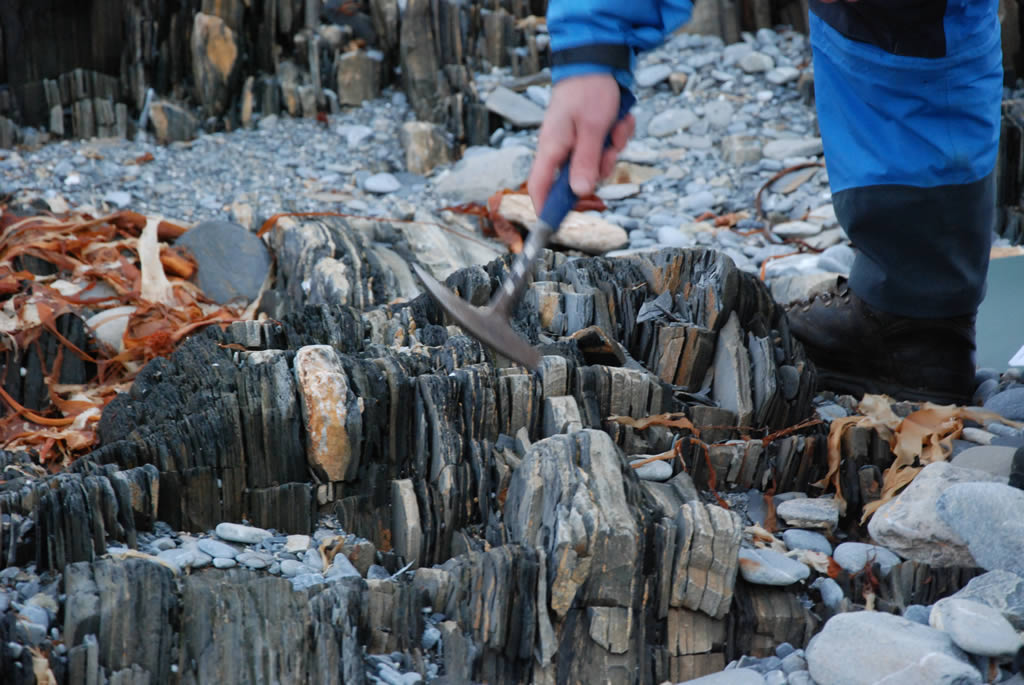 Field work, Midtøya, Svalbard. Early morning 10.9.2016. PHOTO: Håkan Jorikson | Bridge Builder Expeditions Spitsbergen, Voyage I, 2016.
Field work, Midtøya, Svalbard. Early morning 10.9.2016. PHOTO: Håkan Jorikson | Bridge Builder Expeditions Spitsbergen, Voyage I, 2016.
GENETIC HISTORY OF THE SVALBARD REINDEER
The aim of this project is to investigate the genetic history of the subspecies of reindeer that currently inhabits the Svalbard archipelago. The goal of the field work was to collect modern as well as ancient reindeer remains from various locations across Svalbard. These samples are to be analysed using genomic methods, initially to date the samples using the patterns of DNA degradation in each sample. While much cruder than radiocarbon dating, this approach enables identification of the samples that are several thousand years old. This subset of samples can subsequently be radiocarbon dated to determine the exact age of each specimen. Once both comparatively modern and more ancient samples have been identified, DNA will be extracted from them and converted into shotgun sequencing libraries that subsequently will be used to generate whole-genome datasets. Analysis of the resulting genomic data, obtained from different points in time, will be used to investigate i) the timing of when reindeer colonised Svalbard, ii) their demographic history during the Holocene, and iii) to test whether there has been subsequent introgression with domestic reindeer in recent centuries.
During the 2016 expedition, we found and subsampled bones, teeth and antlers collected at several locations on the expedition route along the western coast of Svalbard. These samples are currently held in the frozen collections at the Swedish Museum of Natural History, pending genetic and radiometric analysis. Moreover, the samples will form the basis for a postdoctoral grant application that is to be written during 2018, which if successful will cover not only salary for a postdoc but also the expenses of genetic analyses and dating.
Love Dalén
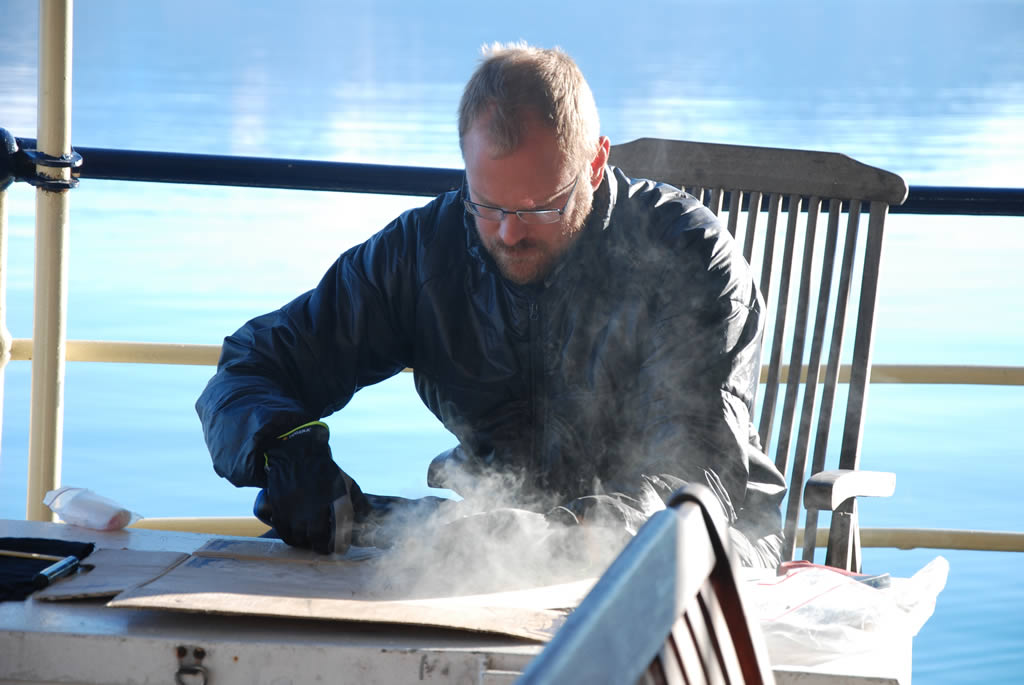 A sample being prepared for scientific examination. PHOTO: Håkan Jorikson | Bridge Builder Expeditions Spitsbergen, Voyage I, 2016.
A sample being prepared for scientific examination. PHOTO: Håkan Jorikson | Bridge Builder Expeditions Spitsbergen, Voyage I, 2016.
RESEARCH OF EXPEDITIONS – DATING FROM 1596 TO 1907
During the expedition I was together with Peter Johansson and Thomas Nydén working with landings and security for work on locations, meaning bear protection. Having prior knowledge of the area we tried to trace historical sources for visits to field locations. I had been involved in the planning of the expedition and its program to follow Anton Rolandsson Martin, but also Friedrich Martens. The later is one of the historical sources that interest me the most and one that also influenced Rolandsson Martin. Friedrich Martens made a comprehensive study of the area of North West Svalbard first published in 1675. The expedition gave me the opportunity to work a bit on tracing some of Marten’s described locations and views and I got to rephotograph one of his drawings from his book, a view of Danskegattet looking east from its western entrance.
I also was given opportunity to rephotograph at some locations where we had done fieldwork in 2012 and working with Per Holmlund and Erik Schytt Holmlund finally located the exact point where Axel Enwall had taken his views of Fuglefjorden in 1872. We also did some additional work on visually mapping the glaciers in Magdalenefjorden where Erik provided the capacity of drone technology to rephotograph some of Adolf Hoels 1907 work on Gullybreen in the fjord. We also visited that glacier following the old tourist trail leading from Trinity Harbor in the cove behind Gravneset. The trail that has been established through years of tourist visits in very large numbers now lead to ’Gully Bay’, a new bay formed, as the glacier has retreated almost entirely from contact with the sea. Visiting Magdalenefjorden with a ship, further gave us the opportunity to rephotograph William Beechey’s 1818 panorama made on a ship from the entrance of the fjord. Beechey’s panorama published in his 1843 book on Buchan’s 1818 expedition was kindly provided to me by the Maritime Museum in London and is an important early rendering of the view of the bay giving us a good sense of the glacial appearance in the area and the way it was perceived in that time. The fjord, first visited by the Dutch in 1596 when Svalbard was discovered, is noted by Rolandsson Martin who sadly enough failed to convince the captain of the ship he was on to sail into the fjord. We were happy to have the greatest relation with our captain and all the crew on M/S Malmö who made it possible for us to enjoy a great journey into the Arctic.
Tyrone Martinsson
![Svalbard, Magdalenefjorden, Gullybreen. PHOTO: [top] 1925 Carl Müller & Son (Courtesy of Andreas Hoenhe), [below] Tyrone Martinsson | Bridge Builder Expeditions Spitsbergen, Voyage I, 2016.](images/turister.jpg) Svalbard, Magdalenefjorden, Gullybreen. PHOTO: [top] 1925 Carl Müller & Son (Courtesy of Andreas Hoenhe), [below] Tyrone Martinsson | Bridge Builder Expeditions Spitsbergen, Voyage I, 2016.
Svalbard, Magdalenefjorden, Gullybreen. PHOTO: [top] 1925 Carl Müller & Son (Courtesy of Andreas Hoenhe), [below] Tyrone Martinsson | Bridge Builder Expeditions Spitsbergen, Voyage I, 2016.
THOUGHTS ON RELIGION AND SCIENCE
In the days of Carl Linnaeus, natural research was partly motivated by a belief in a divine creator. In his Systema Naturae, Linnaeus makes the comment that he has seen the infinite God from behind. So called Natural Theology, which is and has been a part of Christian theology, was especially flourishing in the 18th century. It harbours the idea that creation itself can be explored to find out about the creator, and that this experience of nature as a source for knowledge about the divine is readily available for anyone.
Today, of course, exploration of nature through science is a vast and successful field that needs no external motivation. But are there other connections between the study of nature and transcendent experiences?
During our expedition I conducted short interviews with the other participants about their experience of nature. In general they expressed a great reverence for nature as well as it being an important part of their lives. Several expedition members made connections to childhood memories.
I suggest that in the 18th century, a divine creator was part of a starting point for natural exploration. God could be seen and studied in nature. And today the starting point is nature itself, but still transcendence (which does not have to suggest a belief in a God) is experienced in nature and through natural study. This suggestion would require further study.
Sara Wrige
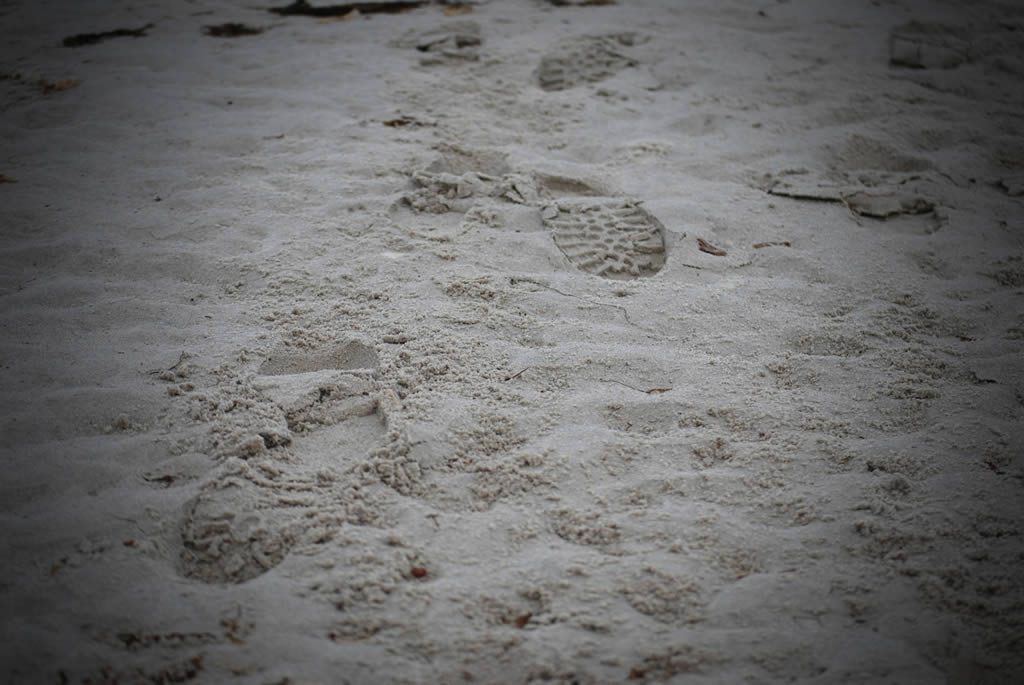 Spoor in the sand. PHOTO: Håkan Jorikson | Bridge Builder Expeditions Spitsbergen, Voyage I, 2016.
Spoor in the sand. PHOTO: Håkan Jorikson | Bridge Builder Expeditions Spitsbergen, Voyage I, 2016.
THE FIELD ARTIST’S REPORT
The Bridge Builder Expeditions Spitsbergen | Voyage I – along the northwest coast of Svalbard gave me an opportunity to retail my visual impressions of the high Arctic with the simplicity and immediacy that the weather and mobility of our team necessitated.
Subject matters for field sketching included some amazing sceneries like fjords and glaciers as well as historical sites near Magdalenefjorden, Midtøya and Hakluytodden. I also portrayed some of the animals such as fulmars that the Barents Sea offered in infinite numbers, purple sandpipers foraging among the tufts of kelp washed ashore at Poolepynten and a group of walruses wallowing on the sandy beach of Smeerenburg.
During my field sketching sessions I waylaid to explore a few of the materials that 18th and 19th century field artists used as well as some modern ones with the ultimate aim to optimise my toolkit for future expeditions in the area. Many of the old pigments are still available and the watercolour brush apparently reached its modern design several centuries ago.
Måns Bergendal
Field artist Måns Bergendal | PHOTO: The IK Foundation/Estvall | Bridge Builder Expeditions Spitsbergen, Voyage I | Click here for more Pictures
ARTISTIC RESEARCH AND DOCUMENTATION
As a visual artist and researcher I participated in the Bridge Builders Expedition in 2016 with a particular interest in registering and documenting material-discursive practices in their skilled and situated dimensions within the domains of both arts and science. During the two week expedition I thus filmed extensively and intuitively, while I kept a diary of field notes. This material has later been examined as part of my artistic research project at Valand Academy of Art in Gothenburg.
While often functioning as visually representative of the High Arctic, Svalbard can also be regarded as a regional anomaly as it never has had any indigenous population. In this sense, my research uses Svalbard as a prism through which to engage Arctic Cinema as a field of concerns, rather than as a label for films portraying or documenting distant Arctic people and geographies. A field concerned with the role of cinema in a contemporary geopolitical image-politics, and thus a field which is itself productive of (and part of) the Arctic.
Over the last seven years I have been returning to Svalbard several times, which has resulted in a material body of interviews, notes, images and film clips. Using experimental film-strategies in which I assemble and voice this material, often in front of a live audience, the aim of my research is more generally to contribute to an understanding of mediation as something significantly different from representation - and to a speculation on the political and aesthetically implications of such an understanding.
In that regard the IK Foundation’s mission of establishing a satellite connecting video- and sound-recording field station, named after the Swedish naturalist Anton Rolandson Martin, has been of interest and inspired the conceptualisation of a series of performative film lectures called by the same name: ‘Martins Eye’. An essay on the matter is included in the anthology Artistic Visions on the Anthropocene North: Climate Change and Nature in Art, to be published by Routledge in spring 2018.
[Report text supplemented in July 2019 | >] As a visual artist working with film-making as a mode of research, my role on board the IK Foundation’s expedition to the archipelago of Svalbard was to document the expedition with video. Later this material has been activated in relation to my artistic research project The Figure of the Guide: Mediating the Arctic Terrain, affiliated with Valand Academy of Art in Göteborg, Sweden. More specifically, I have assembled and voiced the material from the Bridge Builder Expeditions Spitsbergen in front of live audiences at conferences, in theaters and in galleries, whereby I have tried to turn such moments of presentation into moments of production. That is to say, productions of films that are films as far as they set in motion a mode of thinking.
Eva la Cour-Nielsen
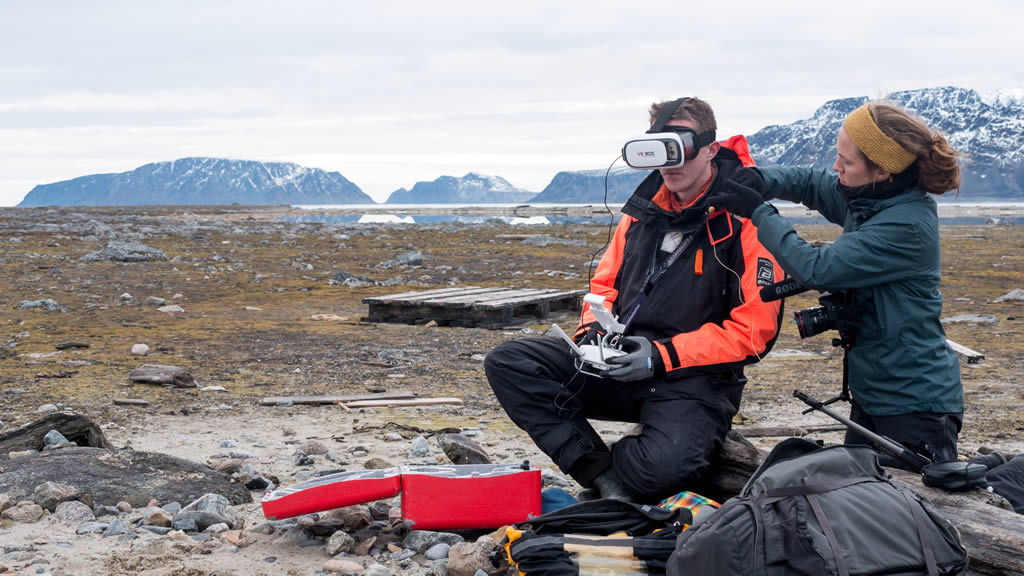 Triple field documentation. PHOTO: Per Holmlund | Bridge Builder Expeditions Spitsbergen, Voyage I, 2016.
Triple field documentation. PHOTO: Per Holmlund | Bridge Builder Expeditions Spitsbergen, Voyage I, 2016.
QUANTIFYING AND MONITOR ICE MASS LOSS FROM ARTIC GLACIERS
The aim of this project is to quantify ice losses; map traces of past ice covers and to establish a basis for future monitoring of glacier size changes. We make use of drones, rephotographs, and GPS measurements in the field. The project is a follow up of a Photographic project run 2012-2015 financed by the Swedish Research Council (VR) aiming at making archived photos of Arctic environments accessible and secured for the future. In this collection including about 10 000 photos there are several detailed panoramas over glacier fronts. Some of them have been rephotographed lately and in 2016 we performed a pilot study for a long term project. We have created digital terrain models over fore fields of some selected glaciers for two purposes, to estimate the volume change over the last 100 years, or from when they were first photographed, and to make a basis for future quantifications of changes by ordinary photos, taken by for example tourists passing by.
During the late 19th century and early 20th century glaciers were of highest interest by geo scientists as a consequence of the newly accepted Ice Age Theory. Therefore glaciers were documented very much in detail. We have a rich documentation from Northern Sweden and from Spitsbergen. In Sweden we have good ground truth data from glacier sites, while the Spitsbergen ones lack such data, which makes quantification of changes difficult. We are developing a simple method for quantifying changes of glaciers.
During the 2016-expedition we made surveys at five different glaciers; Gravnesbreen, Havhestbreen, Larusbreen, Annabreen och Midtre Lovénbreen. Detailed analyses of mass and dynamic changes at Larsubreen and Midtre Lovénbreen have open new perspectives into how glaciers respond to climate change. Additional fieldwork was performed at Nordenskiöld Land after the termination of the cruise and aerial photographs from 1936 and onwards have been analysed.
Per Holmlund and Erik S. Holmlund
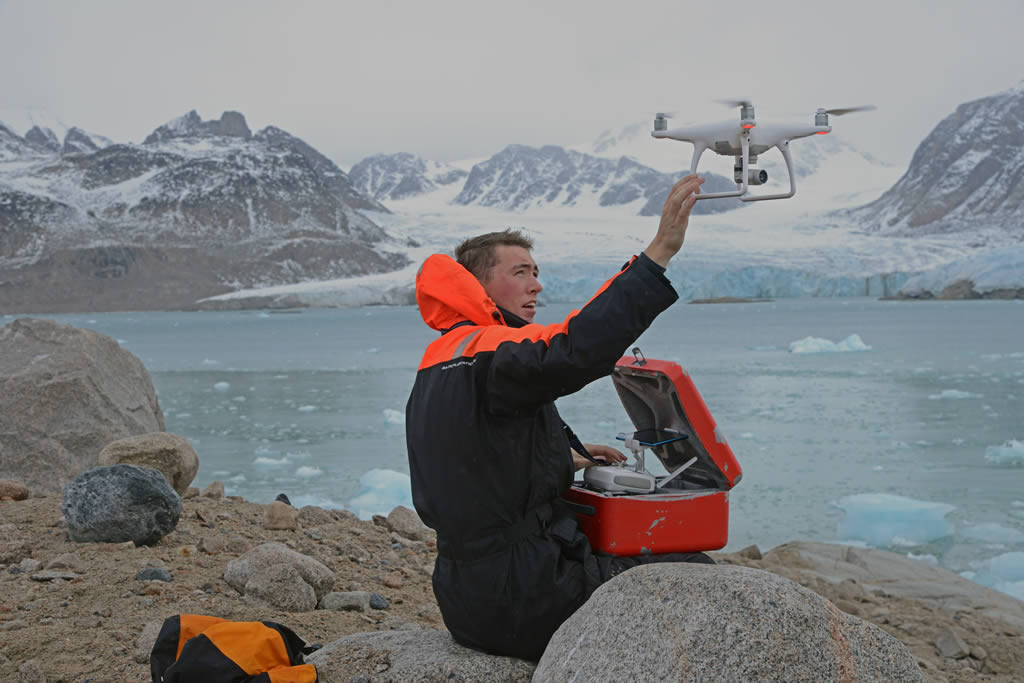 Drone flight in Fuglefjorden in September 2016. PHOTO: Per Holmlund | Bridge Builder Expeditions Spitsbergen, Voyage I, 2016.
Drone flight in Fuglefjorden in September 2016. PHOTO: Per Holmlund | Bridge Builder Expeditions Spitsbergen, Voyage I, 2016.
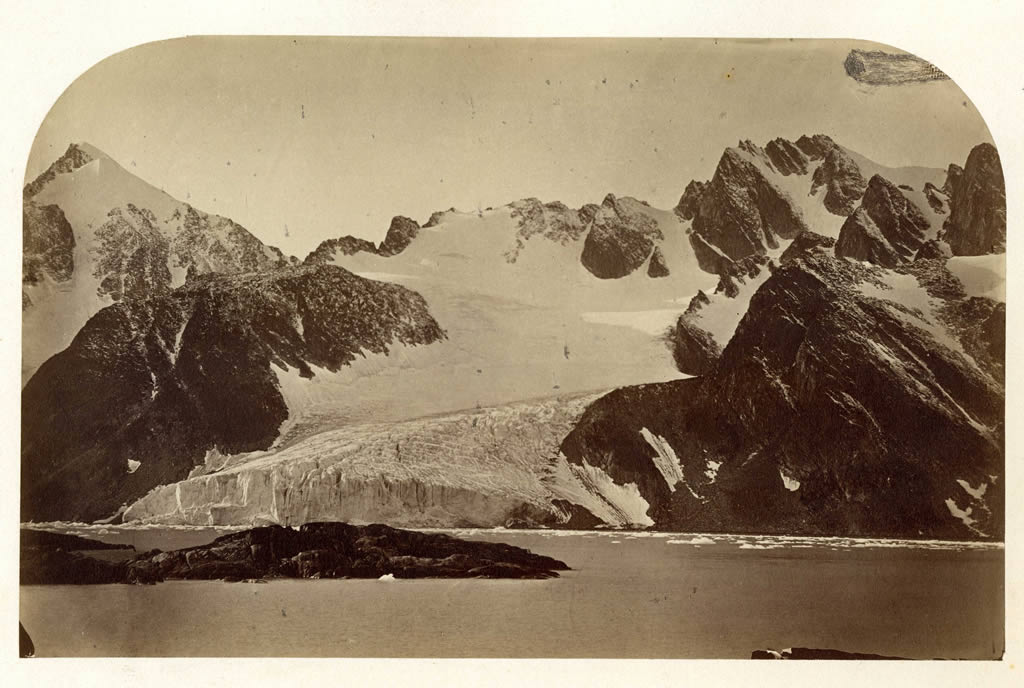 Larusbreen in August 1873. Photo Axel Enwall.
Larusbreen in August 1873. Photo Axel Enwall.
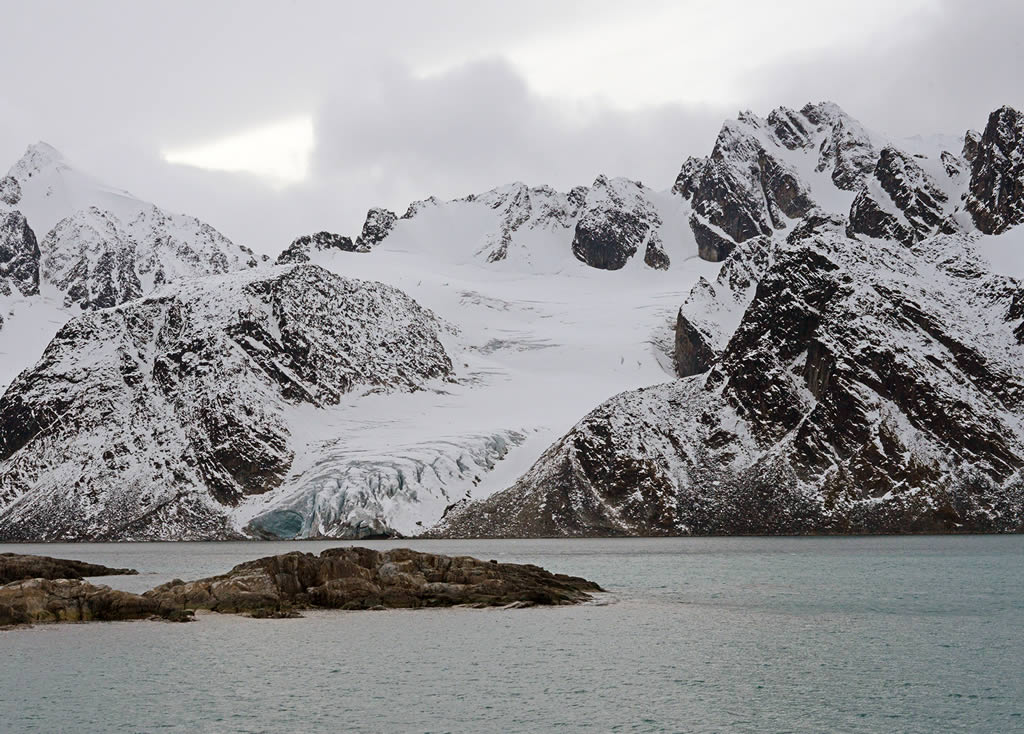 Larusbreen in 2016. PHOTO: Per Holmlund | Bridge Builder Expeditions Spitsbergen, Voyage I, 2016.
Larusbreen in 2016. PHOTO: Per Holmlund | Bridge Builder Expeditions Spitsbergen, Voyage I, 2016.
REFLECTIONS AND IMPRESSIONS DURING A JOURNEY TO SPITSBERGEN
I took part in this expedition as “ear and eye”. My task was to follow hand in hand with the participants in this interdisciplinary group, to collect their reflections and impressions. As doing so I used a recorder to take up interviews as well as sound of Nature itself, and a camera for documentation. My days were spent with scientists in the field as well as with security staff and the artist on board for a broad perspective on reflections, attitudes towards their mission and routines alike. This resulted in more than 1000 images and close to 50 audio-files. It is audio-files – beside interviews - for example of melting ice in Smeerenburg, letting anchor in Magdalene Bay and an abandoned piano in Pyramiden.
One additional task on my behalf was to direct some filming with a drone at Danes Island. Colleague Erik Schytt Holmberg handled the drone simulating the ascending balloon of S A Andrée’s expedition in 1897, flying out towards the north. This film material has been very important for Grenna Museum – Polarcenter, and actually the first material of that kind from the actual site.
As a whole, my mission was fulfilled when it came to documentation as well as my own expectations; learning from colleagues and by visiting new sites.
Håkan Jorikson
Spitsbergen - Running Water. Photo & Audio: Håkan Jorikson | Bridge Builder Expeditions Spitsbergen, Voyage I, 2016.
EXPEDITION PARTICIPANTS
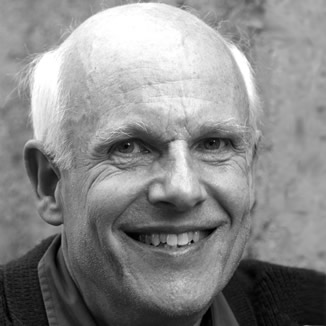
Arne Ardeberg
- (b.) 1940
- DUTY: Participant, researcher.
- AIM: An inspiring, exciting and learning experience in cultural-natural history and preservation of our human habitat. Utile Dulci.
- POST: Professor emeritus in Astrophysics, Lund University, Sweden. Member of Royal Swedish Academy of Sciences, Royal Physiographic Society, Royal Society of Sciences, Chair of Crafoord Prize Committee in Astronomy and LMK-stiftelsen, Foundation for Interdisciplinary Scientific Research.
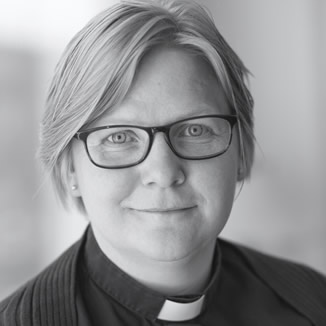
Sara Wrige
- (b.) 1973
- DUTY: Participant, researcher.
- AIM: I very much look forward to cross-disciplinary discussions about the explorations of nature and the impression we take from it. From a theological point nature has always invoked thoughts about God, in the 18th century as well as today.
- POST: Rev.Dr. and minister in the Church of Sweden.
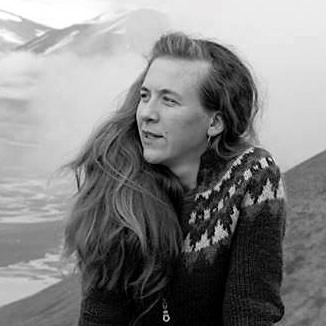
Eva la Cour-Nielsen
- (b.) 1982
- DUTY: Participant, film crew.
- AIM: As a participant of the film crew and my ongoing PhD work – the focus will be to develop my understanding concerning guides and field operating techniques of narrating the Arctic landscape.
- POST: PhD student at University of Gothenburg, Academy Valand, Sweden.
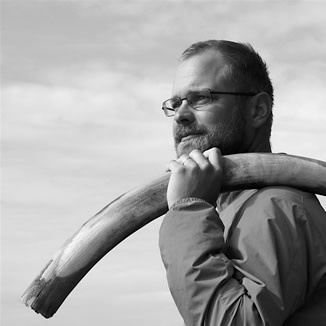
Love Gunnar Dalén
- (b.) 1975
- DUTY: Participant, researcher.
- AIM: The aim of my project is to investigate the evolutionary history of the Svalbard reindeer using DNA from ancient reindeer remains collected during the expedition.
- POST: Professor of Evolutionary Genetics, Swedish Museum of Natural History.
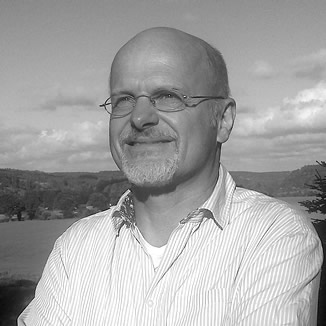
Jonas Hagström
- (b.) 1959
- DUTY: Participant, researcher.
- AIM: The expedition is an unique chance for me to help bring this forgotten Linnaean apostle out of the shadows and into the light.
- POST: Curator, The Swedish Museum of Natural History.
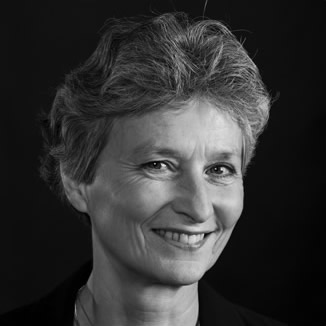
Anna Helga Hannesdóttir
- (b.) 1952
- DUTY: Participant, researcher.
- AIM: By taking part in the expedition to Svalbard, my hope is to get a better understanding for the conditions of the Linnaeus Apostles’ fieldwork.
- POST: Professor in Nordic languages, University of Gothenburg, Sweden.
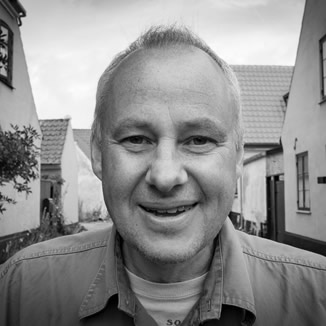
Lars Hansen
- (b.) 1960
- DUTY: Expedition leader, researcher.
- AIM: To strengthen our insight of the fieldwork that the so-called Linnaeus Apostles started almost three centuries ago. To understand Natural and Cultural History of Planet Earth – and hopefully building "new bridges of proficiency" between the past, present and future!
- POST: Head at The IK Foundation, FRGS, London, United Kingdom.
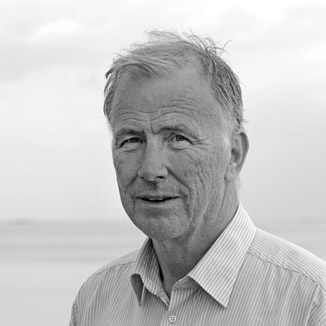
Per Holmlund
- (b.) 1956
- DUTY: Participant, researcher.
- AIM: To study changes in extent and volume over the last century on a number of glaciers along the expedition route. The field methods are terrestrial and aerial photography, rephotography and geodetic surveys. The aerial photographs will be provided by a drone. The aims are to make use of old photographs taken in late 19th century for quantitative analyses and to make digital terrain models for future surveys of changes in glacier extents.
- POST: Professor in glaciology, Stockholm university, Sweden.
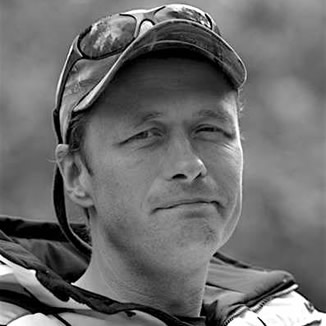
Peter Johansson
- (b.) 1967
- DUTY: Participant, field assistant.
- AIM: My duty will be to ensure that all expedition participants may be able to do their jobs well in the field under safe conditions. This is also a great opportunity for me to return to see the dramatic and stunning landscapes of Svalbard.
- POST: Field & research assistant, fish ecologist, Emåförbundet, Sweden.
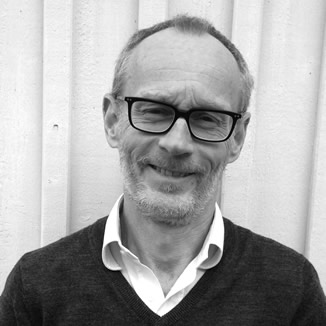
Håkan Jorikson
- (b.) 1959
- DUTY: Participant, researcher, recorder.
- AIM: I will be the "ear and eye" in an inter-disciplinary group to collect reflections and impressions for a forthcoming exhibition.
- POST: Museum director of Grenna Museum and Polar Centre, Sweden.
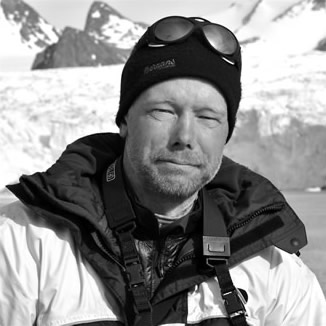
Tyrone Martinsson
- (b.) 1967
- DUTY: Participant, researcher, field operator.
- AIM: I am joining the BBES for the comparative study of historical data with focus on Anton Rolandsson Martin 1758 and Friedrich Martens 1671, concerning the landscape and its changes on the planned route along the north west coast of Spitsbergen.
- POST: Senior lecturer, University of Gothenburg, Academy Valand, Sweden.
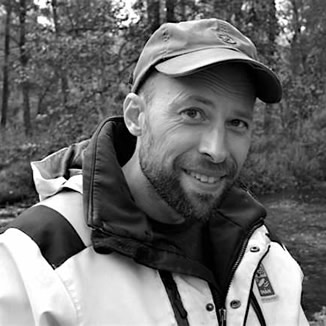
Thomas Nydén
- (b.) 1972
- DUTY: Participant, field assistant.
- AIM: My essential contribution to the expedition will be to serve for safety and assistance to the other members. At the same time, it will be an unforgettable experience to visit the Arctic landscape together with interesting people.
- POST: Field & research assistant, limnologist, Emåförbundet, Sweden.
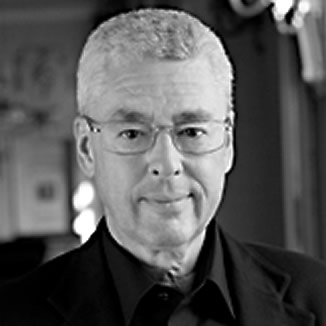
Bo Ralph
- (b.) 1945
- DUTY: Participant, researcher.
- AIM: Carolus Linnæus and his »apostles» have had a crucial impact on the standardization of the Swedish language in the 18th century. More knowledge about their working conditions gives a special dimension to their contribution in this respect.
- POST: Professor emeritus in Nordic Languages, University of Gothenburg, Sweden and Member of the Swedish Academy.
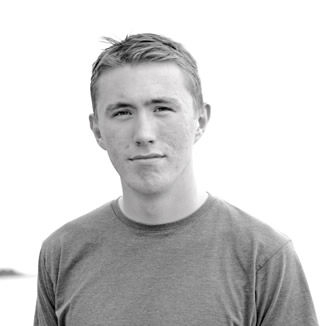
Erik Schytt Holmlund
- (b.) 1996
- DUTY: Participant, field & research assistant.
- AIM: To map the frontal area of the glaciers encountered along the trip using aerial photography with a drone. The collected data will be used to further improve this mapping technique. I will also assist my father, Per Holmlund, in retaking photographs from historical perspectives.
- POST: Student.
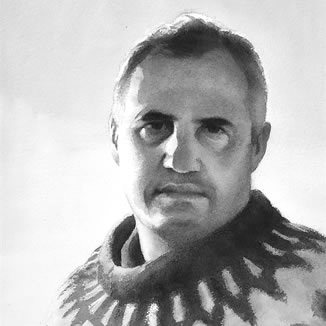
Måns Bergendal
- (b.) 1964
- DUTY: Participant, field artist.
- AIM: I want to convey what I see with immediacy and simplicity to make the viewer feel present on the Arctic scene. Watercolor is the most portable medium and an excellent one for this purpose.
- POST: Watercolour artist, illustrator and instructor, Lund, Sweden.
EXPEDITION SHIP CREW
- Master, Johannes Malmlund
- Chief Officer, Sophie Galvagnon
- AB, Pontus Andersson
- AB, Thomas Andersson
- Chief Engineer, Håkan Reis
- Chef, Christian Cederberg
- Stewardess, Anna Seldén
EXPEDITION BACK BASE
- Webmaster, digital network: Jeff Snoxell
- Art work: Graham Scott
- Research: Viveka Hansen
- Controller: Jennie Asher
- Maritime lawyer: Bo Benell
- Technical adviser iEye: Torben Andersen
- News Room: Jens Hansen
- The Reception Desk: Leo Ryder
EXPEDITION PATRONS
- The Swedish Museum of Natural History
- The Thora Ohlsson Foundation
- LMK-stiftelsen, Foundation for Interdisciplinary Scientific Research
- Stiftelsen Olle Engkvist Byggmästare
- The Swedish Academy
iPROJECTS
- (Main title) The Linnaeus Apostles BRIDGE BUILDER EXPEDITIONS To Understand Planet Earth
- (Subtitle) BRIDGE BUILDER EXPEDITIONS - Spitsbergen (Svalbard)
- FIELD STATION | NATURAE OBSERVATIO | MARTIN’S EYE
- Spitsbergen, Svalbard; in the agreement of the international Spitsbergen treaty (Svalbard treaty)
- Geography
- 18th century Studies'
- Cultural History
- History of Science
- Natural History
- Economic History
- Field Notes, Arts and Photography
- Field station, long-term observations
- Ecology
- The IK Foundation, London, United Kingdom
- Natural History Museum University of Stockholm, Sweden
- Grenna Museum Polarcenter, Sweden
- University of Gothenburg, Sweden
- The Norwegian Meteorological Institute, Norway
- Lund university, Sweden
- The Royal Geographical Society (with IBG), United Kingdom
- The Swedish Academy, Sweden
- Stockholm university, Sweden
- University of Tromsø, Norway
- INTERACT | International Network for Terrestrial Research and Monitoring in the Arctic, EU
- GBIF | Global Biodiversity Information Facility, Norway & United Kingdom
- Natural History Museum University of Oslo, Norway
- Department of Biology, Lund University, Sweden
- Lund Observatory, Department of Astronomy and Theoretical Physics, Lund University, Sweden
- UNIS Aurora Observatory: The Kjell Henriksen Observatory (KHO), Svalbard.
- The Swedish Museum of Natural History, Sweden
- The Thora Ohlsson Foundation, Sweden
- LMK-stiftelsen, Foundation for Interdisciplinary Scientific Research, Sweden
- Stiftelsen Olle Engkvist Byggmästare, Sweden
- The Swedish Academy, Sweden
- 2016: Expedition Voyage I: Field work, research, documentation and follow-up work.
- 2017: Expedition Voyage II: Field work, research, documentation and follow-up work.
- 2018: Expedition Voyage III: Field work, research, documentation and follow-up work.
- 2019: Expedition Voyage IV:A (May) and Voyage IV:B (September/October): Field work, research, documentation and follow-up work.
- 2020: Expedition Voyage V: Dismantling of the Field Station, documentation and follow-up / planning of publicise work.
- 2021: Research, follow-up work, Publicise work of Publication | Exhibition | Multimedia, with the title NATURAE OBSERVATIO SPITSBERGEN | SCIENCE EXPEDITIONS | TEXTS & OBSERVATIONS FROM THE PAST TO PRESENT TIME.
- 2023/24: International launch of the publicise work of Publication | Exhibition | Multimedia, with the title NATURAE OBSERVATIO SPITSBERGEN | SCIENCE EXPEDITIONS | TEXTS & OBSERVATIONS FROM THE PAST TO PRESENT TIME.
- iLINNAEUS.org
- Publicise work of Publication | Exhibition | Multimedia, with the title NATURAE OBSERVATIO SPITSBERGEN | SCIENCE EXPEDITIONS | TEXTS & OBSERVATIONS FROM THE PAST TO PRESENT TIME.
- Field Station | Naturae Observatio
- Expedition Picture Portfolio
- Expedition Video Portfolio
- Expedition Panoramic Portfolio
- Research in Svalbard (RIS)
- RIS-ID 10275 (Bridge Builder Expeditions Spitsbergen)
- RIS-ID 11055 (Field Station Research Projects)
- The Norwegian Polar Institute's topographical Svalbard map portal
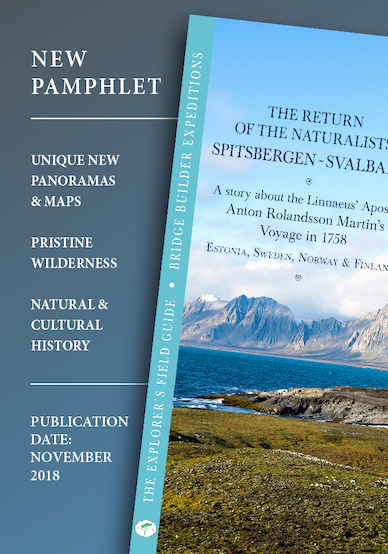
been copied to your clipboard




– a truly European organisation since 1988
Legal issues | Forget me | and much more...
You are welcome to use the information and knowledge from
The IK Workshop Society, as long as you follow a few simple rules.
LEARN MORE & I AGREE











